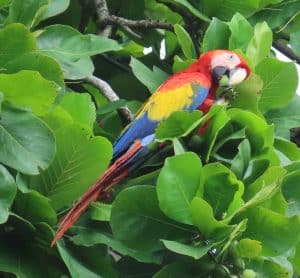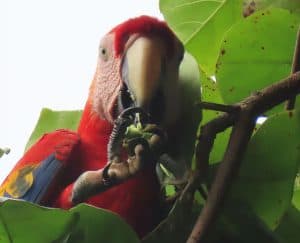\Few sights in Costa Rica are as unforgettable as a pair of scarlet macaws gliding over the rainforest canopy, trailing flashes of red, yellow, and blue. These iconic parrots were once in sharp decline due to habitat loss and poaching — but thanks to focused conservation efforts and the regrowth of key food sources like the beach almond tree, they’re making a colorful comeback.

Scarlet macaws (Ara macao) are one of the largest and most vibrant parrots in the Americas. Once widespread across Costa Rica, their numbers dropped dramatically due to deforestation and the pet trade. Today, the wild scarlet macaw population is estimated at over 2,000 individuals, with thriving populations along the Pacific coast.
A major factor in their resurgence, especially along the Pacific, is the abundance of beach almond trees (Terminalia catappa). While macaws eat a variety of seeds, fruits, and nuts, they have a strong preference for the beach almond’s large, oily seeds, which provide essential calories — especially in areas where these trees have been reintroduced.

Top 3 Places to Spot Scarlet Macaws in Costa Rica
If scarlet macaws are on your must-see list, here are three top destinations where Reefs to Rockies travelers frequently encounter these majestic birds:
- Carara National Park – Located in the Central Pacific, Carara is one of the best spots in the country to observe wild scarlet macaws. They’re often seen flying in pairs or feeding in trees along the forest edges and along the Tarcoles River.
- Osa Peninsula – A remote biodiversity hotspot with lush rainforest and healthy macaw populations. Watch for pairs soaring over the treetops or squawking from perch trees near the coastline.
- Punta Islita – On the Nicoya Peninsula, this community has become a conservation success story, with macaw reintroduction programs and forest regeneration creating a haven for these vibrant parrots.
Fun Facts About Scarlet Macaws
- They can be left- or right-“handed”! Macaws show a preference for using one foot over the other to grasp food, much like human handedness.
- They love beach almond trees for feeding, often gathering in groups to crack open the tough outer shells and access the nutrient-rich seeds inside.
- Scarlet macaws mate for life and are almost always seen in pairs or family units of three. Their powerful calls can travel over a mile through the forest canopy.
Seeing a scarlet macaw in flight is pure rainforest magic — and with Costa Rica’s expanding conservation success, your chances of encountering more than one scarlet macaw have never been better. Let Reefs to Rockies design your custom Costa Rica itinerary for up-close wildlife experiences with expert guides who know where the birds (and beach almonds) are.
